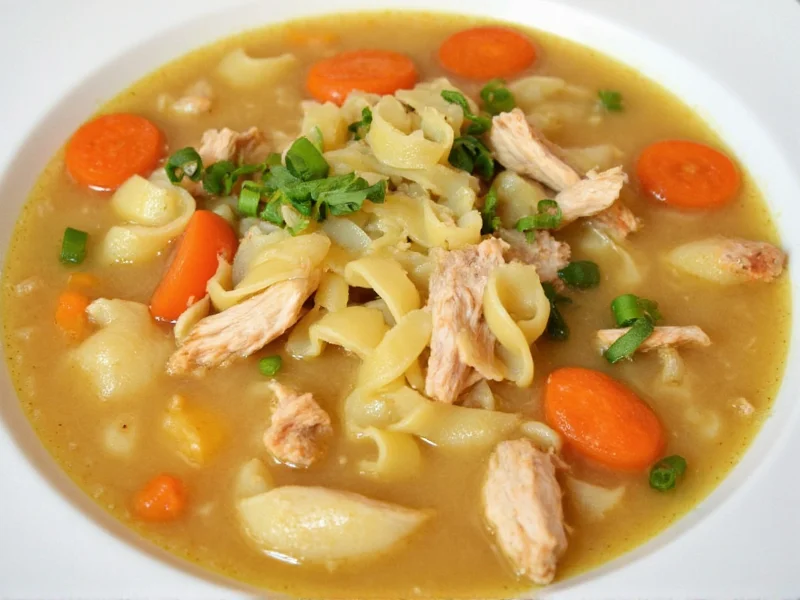Chicken noodle soup remains a beloved comfort food worldwide, cherished for its soothing warmth and nourishing qualities. Whether you're cooking for a cold winter day or seeking that classic remedy when feeling under the weather, mastering this timeless recipe brings both satisfaction and practical nourishment to your kitchen.
Essential Ingredients for Authentic Flavor
The foundation of exceptional chicken noodle soup lies in quality ingredients. While variations exist across cultures, the traditional American-style version relies on specific components that work in harmony. Understanding why each ingredient matters helps you make informed substitutions without compromising the final result.
| Ingredient | Quantity | Why It Matters |
|---|---|---|
| Bone-in chicken pieces | 1.5 lbs | Provides rich flavor and gelatin for broth body |
| Homemade or quality store broth | 8 cups | Forms the soup's flavor foundation |
| Carrots | 2 medium, diced | Adds natural sweetness and texture |
| Celery | 2 stalks, diced | Contributes aromatic depth |
| Yellow onion | 1 medium, diced | Builds flavor base |
| Egg noodles | 8 oz | Traditional texture that holds up in broth |
| Fresh parsley | 3 tbsp chopped | Adds brightness and color |
| Fresh dill (optional) | 2 tbsp chopped | Enhances herbal notes |
Equipment You'll Need
Having the right tools makes the process smoother. A heavy-bottomed stockpot (6-8 quarts) ensures even heating without scorching. A fine-mesh strainer helps remove impurities from your broth. While not essential, a ladle makes serving easier, and a sharp chef's knife speeds vegetable prep. For those making broth from scratch, a slotted spoon helps remove solids efficiently.
Step-by-Step Cooking Instructions
Follow these detailed steps for chicken noodle soup with perfectly balanced flavors and textures. This method produces a clear broth with tender chicken and ideally cooked noodles.
- Prepare the broth base: Place chicken pieces in a large pot with 8 cups cold water. Bring to a gentle simmer over medium heat (do not boil vigorously). Skim off any foam that rises to the surface during the first 10 minutes.
- Build flavor: Add onion, celery, and carrot to the pot. Include 2 bay leaves, 1 teaspoon black peppercorns, and a small bunch of fresh thyme. Simmer uncovered for 45 minutes, allowing flavors to meld while keeping the broth clear.
- Remove and shred chicken: Carefully remove chicken pieces with a slotted spoon. Let cool slightly, then shred the meat, discarding skin and bones. Return shredded chicken to the pot.
- Cook the noodles: Bring broth back to a gentle boil and add egg noodles. Cook according to package directions minus 2 minutes (they'll continue cooking in the hot broth). Overcooked noodles become mushy and ruin the soup's texture.
- Final seasoning: Stir in fresh parsley and dill. Season with salt to taste (start with 1 teaspoon). For brighter flavor, add 1 tablespoon lemon juice just before serving.
Avoiding Common Chicken Soup Mistakes
Many home cooks encounter issues with their chicken noodle soup. Understanding these pitfalls ensures restaurant-quality results every time:
- Boiling instead of simmering: Vigorous boiling makes broth cloudy and can toughen chicken. Maintain a gentle simmer throughout cooking.
- Adding noodles too early: Egg noodles continue cooking in hot broth. Add them just before serving to maintain ideal texture.
- Over-seasoning early: Salt concentration changes as liquid reduces. Season in stages, with final adjustments before serving.
- Skipping the skimming step: Removing foam during initial heating produces a clearer, cleaner-tasting broth.
- Using low-quality broth: Even when making from scratch, supplementing with a high-quality store-bought broth enhances depth of flavor.
Storage and Reheating Guidelines
Chicken noodle soup stores exceptionally well, making it ideal for meal prep. Cool the soup completely before storing to prevent condensation. Keep broth and noodles separate if possible—noodles absorb liquid and become mushy when stored in broth.
Refrigerate in airtight containers for up to 4 days. For longer storage, freeze without noodles (add fresh noodles when reheating). When reheating, warm gently over medium-low heat to preserve texture. If noodles have absorbed too much broth, add a splash of water or additional broth.
Variations for Different Dietary Needs
Traditional chicken noodle soup adapts beautifully to various dietary requirements without sacrificing flavor:
- Gluten-free version: Substitute egg noodles with rice noodles or gluten-free pasta. Add them during the final 5 minutes of cooking.
- Low-sodium option: Use unsalted broth and enhance flavor with extra herbs, lemon zest, and garlic. Season with salt only at the table.
- Extra protein boost: Add white beans or chickpeas during the last 10 minutes of cooking for additional protein without changing the soup's character.
- Vegetable-packed version: Include additional vegetables like peas, spinach, or kale during the final minutes of cooking for added nutrition.
Serving Suggestions for Maximum Enjoyment
Serve chicken noodle soup hot but not scalding—around 165°F (74°C) allows flavors to shine without burning your mouth. A squeeze of fresh lemon just before serving brightens the flavors. Pair with crusty bread for dipping or a simple green salad for a complete meal.
For those seeking the ultimate comfort experience, garnish with additional fresh herbs, a sprinkle of red pepper flakes for heat, or a dollop of pesto for an unexpected flavor twist. The key to perfect chicken noodle soup lies in balancing simplicity with thoughtful preparation.











 浙公网安备
33010002000092号
浙公网安备
33010002000092号 浙B2-20120091-4
浙B2-20120091-4